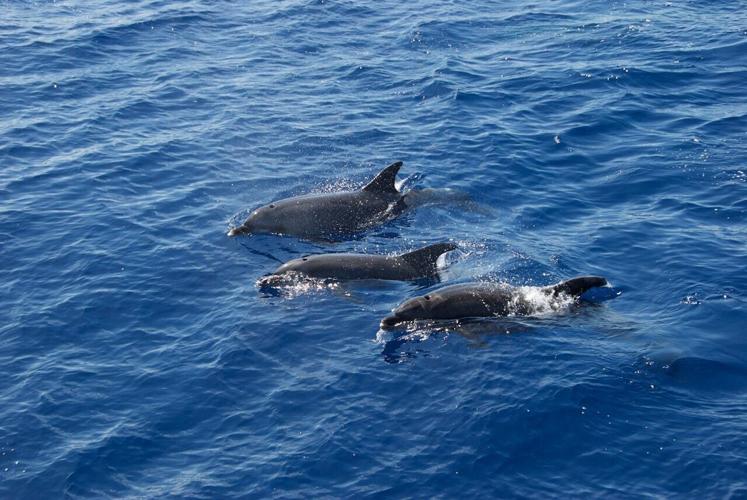
(Photo by Neil Harvey via Pexels)
By Stephen Beech
Dolphins are dying seven years younger in the North Atlantic, warns "alarming" new research.
Common dolphins - among the ocean’s most abundant mammals - are living for an average of 17 years rather than 24 years in the 1990s, say scientists.
American rResearchers discovered that the longevity of female common dolphins has dramatically decline since 1997, a worrying trend that they say threatens not only the species but also the marine ecosystem it helps maintain.
Dr. Etienne Rouby, of the University of Colorado Boulder's Institute of Arctic and Alpine Research (INSTAAR), said: “There is an urgent need to manage the population better.
"Otherwise, there is a risk for decline and, ultimately, extinction.”
Around six million common dolphins roam tropical and temperate oceans around the world.
They are the world’s most common cetaceans - a group that includes whales, dolphins and porpoises.
The Bay of Biscay, off the French coast, is a popular winter destination for dolphins, because its warmer, nutrient-rich waters attract smaller species of fish - such as anchovies and sardines - that they like to eat.
But scientists say those same conditions also make it one of Europe’s fishing hotspots.

Shaain Ibrahim
While dolphins are not the target of fishing, many of them end up in nets by accident, known as “bycatch”.
Most dolphins caught as bycatch die.
Some studies estimate that in 2021, fishing bycatch was responsible for the deaths of 6,900 dolphins in the Bay of Biscay, from a winter population of 180,000.
Despite those numbers, traditional monitoring methods previously suggested that the dolphin population in the bay was stable.
Scientists estimated dolphin numbers by tallying individuals spotted from survey ships and planes.
But, because dolphins are constantly moving in and out of a region, that approach can miss population changes until drastic shifts occur.
For long-lived animals that only produce a few offspring in their lifetimes, such as dolphins, Dr. Rouby says that recovery may not be possible once population declines are significant enough to show up in general counts.
He and his team set out to re-evaluate how well dolphins were surviving using a new approach they developed: counting and analysing deceased dolphins stranded on beaches in the bay.

Torsten Dederichs
Dr. Rouby explained that dolphins often come onto the shore because they are old, sick, injured or disoriented, and rarely any survives after being stranded.
While stranded dolphins represent only around 10% of total dolphin deaths, he said changes in their mortality patterns over time can reveal broader population trends.
The team studied 759 common dolphins stranded on beaches along the Bay of Biscay between 1997 and 2019.
Dr. Rouby said: “We wanted to capture changes in the population’s survival and fertility rates.
"These are more sensitive indicators of population health, and they enable us to identify the problems before they become irreversible."
By analysing dolphin teeth, the team determined the age at which they died.
The team found that female dolphins’ longevity decreased from 24 years in the late 1990s to just 17 years two decades later.
This decline has led to fewer calves born, suggests the study published in the journal Conservation Letters.
The researchers estimated that the dolphin population growth rate has declined by 2.4% from 1997 to 2019.
In ideal conditions, a healthy common dolphin population grows at about 4% per year.
That means if the population was "thriving perfectly" in 1997, it was only growing at 1.6% annually by 2019.
Dr. Rouby said: “The numbers are likely to be lower in reality."

Martha Mazariegos
If the trend continues, he says the growth rate could dip below zero, a threshold that would signal population decline.
Since 2024, the French government has been closing the Bay of Biscay to fishing for one month every January to protect the dolphins.
While some data has suggested the measure has been helpful, Dr. Rouby said a more "flexible" schedule could work better.
Depending on ocean conditions, he says dolphins may arrive at the bay earlier or later than the set period in January, so timing fishing restrictions to match dolphin visits would better protect the animals.
Dr. Rouby warned other cetaceans in the North Atlantic - including Harbor porpoise and bottlenose dolphins - may also be experiencing similar declines.
He said: “Dolphins are the top predators in the Bay of Biscay, and they play a very important role in the ecosystem.
"Without these predators, fish populations could become out of control, and they would in turn consume too much plankton and vegetation until the system collapses."
Dr. Rouby added: “As humans, we should make conscious decisions to protect the living and non-living things around us.
"Facing evidence of viability loss, we need to act before it is too late.”
























(0) comments
Welcome to the discussion.
Log In
Keep it Clean. Please avoid obscene, vulgar, lewd, racist or sexually-oriented language.
PLEASE TURN OFF YOUR CAPS LOCK.
Don't Threaten. Threats of harming another person will not be tolerated.
Be Truthful. Don't knowingly lie about anyone or anything.
Be Nice. No racism, sexism or any sort of -ism that is degrading to another person.
Be Proactive. Use the 'Report' link on each comment to let us know of abusive posts.
Share with Us. We'd love to hear eyewitness accounts, the history behind an article.